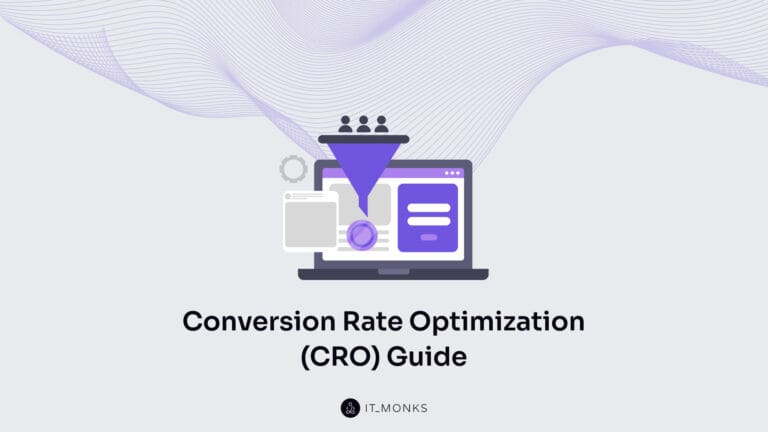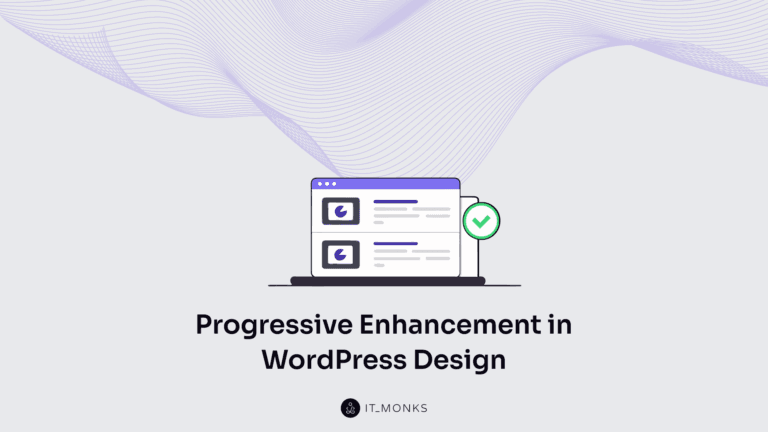Enterprise Hosting Portability and Vendor Lock-in
Table of Contents
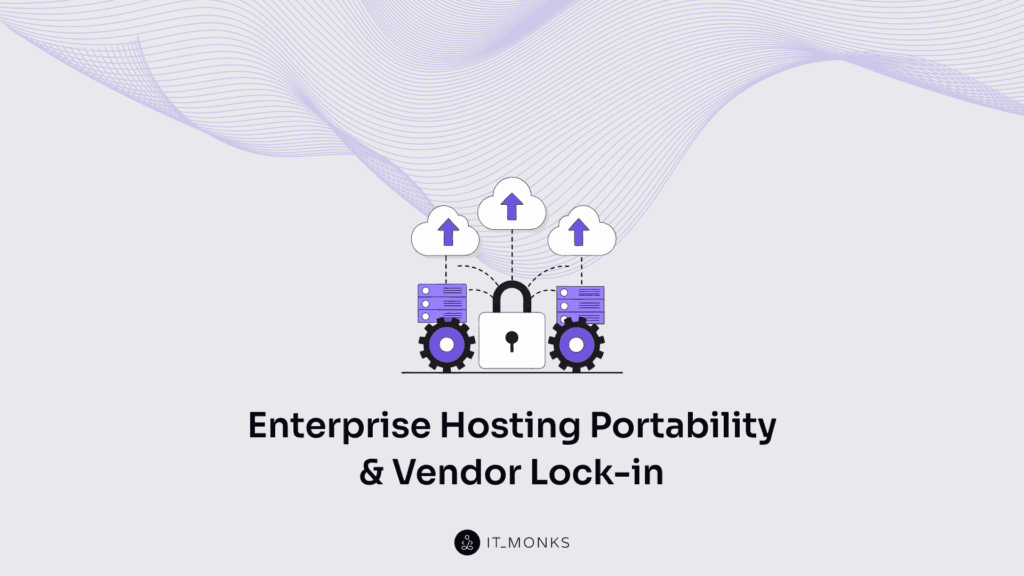
Enterprise hosting forms the infrastructural backbone of any enterprise website, shaping its operational continuity and long-term adaptability. As a foundational component, it embeds architectural traits that directly influence development trajectories, particularly through the attributes of portability and vendor lock-in.
Hosting portability determines how easily an enterprise website can be migrated across platforms or providers without disruption. Beyond server compatibility, it encompasses configuration replication, decoupled software stacks, persistent APIs, and format-neutral data exports.
When well-executed, portability establishes infrastructure independence, allowing seamless data transfer, preserved integration layers, and consistent performance under shifting environments. It supports strategic resilience, reduces friction in replatforming or geographic scaling, and stabilizes cost structures over time.
Conversely, vendor lock-in introduces friction through proprietary systems, non-transferable licenses, and rigid service contracts that constrain architectural decisions. It limits interoperability, raises exit barriers, and slows the adoption of modern frameworks or third-party integrations.
Deep entrenchment, whether through custom CMS features, closed APIs, or SLA restrictions, narrows flexibility, often converting necessary upgrades into costly transitions.
Within the context of enterprise website development, these attributes directly impact agility, technical debt, and long-term digital viability. While portability enables migration, scalability, and integration freedom, vendor lock-in restricts architectural evolution and increases operational risk.
Evaluating hosting choices, therefore, becomes a strategic imperative that defines how effectively an enterprise website can respond to change, adopt innovation, and remain competitive in dynamic digital ecosystems.
Vendor Dependency
Vendor dependency is a structural consequence of enterprise hosting decisions that prioritize proprietary ecosystems over interoperability. Hosting providers embed closed frameworks and controlled environments that enforce rigid development protocols, restrict configuration freedom, and eliminate code portability.
These architectures entrench the enterprise website hosting within platform-specific systems, resulting in license entanglement, interoperability loss, and limited alignment with vendor-neutral standards.
Contractual terms further reinforce this dependence through legal instruments that bind operations to predefined conditions. Service-level agreements frequently include exclusivity clauses, exit penalties, and renewal traps, which collectively inflate switching costs and extend vendor control into the decision-making layers of infrastructure management.
Functional restrictions also materialize through bundled features that are tightly coupled to the hosting provider’s platform. Vendors often lock essential services behind proprietary implementations, preventing their replication outside the ecosystem and forcing the enterprise website to anchor its core logic to non-transferable capabilities.
Vendor selection, therefore, shapes the entire development stack by dictating framework adoption, limiting upgrade paths, and narrowing API integration options. Contracts structure the lifecycle around exit friction and long-term liabilities, while platform-specific packaging constrains the website’s ability to evolve in response to operational needs or innovation opportunities.
This dependency manifests through 3 core dimensions: architectural frameworks, legal contracts, and platform-level features. Each imposes a distinct set of constraints on the enterprise website’s portability, adaptability, and long-term agility. Recognizing and managing this embedded reliance is essential to building a resilient and strategically flexible enterprise hosting architecture.
Proprietary Frameworks
Proprietary frameworks restrict enterprise hosting portability by design. These closed ecosystems enforce rigid deployment structures and vendor-controlled codebases that bind hosting environments to specific platforms.
Through embedded runtime modules and mandatory SDKs, proprietary frameworks dictate an architecture that is neither transferable nor modular, turning enterprise websites into immobile assets tied to the framework’s constraints.
By imposing inflexible API models and deployment pipelines, proprietary frameworks obstruct compatibility with external systems. Their custom API bindings lock application logic into a singular runtime, making cross-platform migration technically infeasible without extensive restructuring.
This tight architectural coupling extends beyond backend functions, anchoring everything from CMS behavior to integration workflows within the framework’s stack rigidity.
As a result, enterprise websites inherit operational limitations that reduce adaptability and complicate infrastructure optimization. Strategic consequences quickly follow: platform-specific deployment restricts scalability, enforces vendor-paced upgrade cycles, and accumulates technical debt over time.
Without the ability to decouple components, websites lose the flexibility to align infrastructure with evolving business goals or cost-efficiency strategies.
When integration layers are enforced through proprietary tooling, even routine actions, like extending CMS capabilities or connecting third-party services, are obstructed by platform incompatibility. Over time, these constraints transform architectural decisions into legal and logistical liabilities, setting the stage for further entrenchment through contractual obligations and compliance restrictions.
Legal Contract Limitations
Legal contract limitations function as binding constraints within enterprise hosting environments, where vendor agreements restrict operational parameters by specifying how infrastructure resources may be used, scaled, or discontinued, tethering the enterprise to the provider’s control.
Hosting licenses are typically non-transferable, bound to proprietary ecosystems that prohibit migration or replication by explicit legal design.
Minimum commitment durations and early termination clauses further penalize exit attempts, imposing financial liabilities tied to unused service periods and deterring transitions even when technically feasible. These costs are structured deterrents that make migration economically impractical.
At the same time, vendor-imposed SLAs condition performance guarantees on static infrastructure, with transitional changes during migration triggering reduced coverage or voided entitlements, thereby restricting the flexibility of service modification.
Intellectual property clauses limit ownership over custom deployments, with code developed within the vendor’s environment often classified as shared or vendor-controlled IP. This restricts the enterprise’s ability to extract or reuse critical systems, such as CMS customizations or backend integrations, without exposing itself to legal risk.
Together, these limitations, license scope, commitment terms, SLA constraints, and IP entitlements govern portability at every level. For enterprise websites, the result is a structurally enforced dependency, where migration is systematically constrained by legal enforcement. These contracts, in tandem with proprietary frameworks, form a dual-lock architecture that defines vendor control in enterprise hosting.
Feature-Based Usage Constraints
Feature-based usage constraints lock enterprise websites into vendor environments by embedding critical functionalities into non-transferable, system-bound modules.
These include CMS-specific extensions, hosting-layer security tools, proprietary analytics dashboards, and automation workflows, each structurally integrated to restrict portability and limit configuration outside the original environment.
Framed as operational benefits, these components embed core processes into platform-exclusive architectures, reinforcing functional dependency.
CMS-tied modules confine editorial workflows, custom post types, and templating engines to vendor-specific logic, disabling key components if migrated. Security services entrench control further by conditioning access and filtering mechanisms to the host infrastructure, often without open documentation or interoperable APIs. These integrations resist adaptation, making replication elsewhere technically infeasible.
Caching systems and backup schedulers bind optimization and redundancy routines to host-native settings, where operational behavior cannot be preserved beyond the vendor’s ecosystem.
Even if data and code are portable, the orchestration layer, how and when tasks execute, remains tethered. Workflow platforms, from analytics suites to deployment pipelines, deepen this rigidity by embedding process control into closed interfaces with no export support or external integration.
Together, these constraints elevate migration friction and tether the enterprise website to the hosting provider’s ecosystem. Even when exit is viable in theory, the operational fallout, lost functionality, impaired performance, and broken workflows translate into high switching costs. What begins as convenience becomes structural lock-in, designed to reinforce dependency and obstruct platform exit.
Integration Constraints
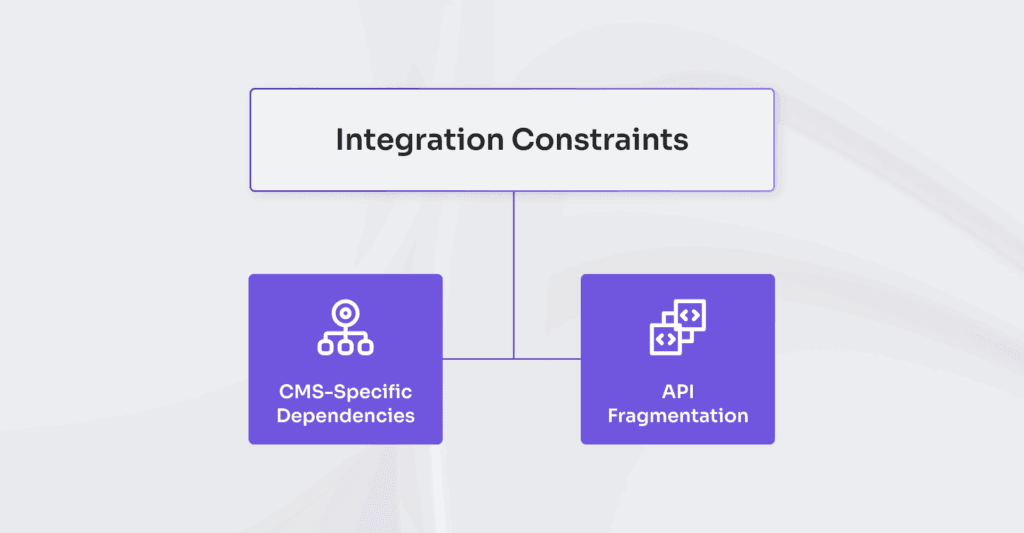
Integration constraints arise when enterprise hosting environments restrict or complicate the interaction between internal systems, services, and external applications. These limitations are not incidental flaws but intentional outcomes of rigid hosting architectures designed to enforce control.
By embedding proprietary SDKs, unsupported protocols, or version-specific APIs, hosting platforms construct closed ecosystems that obstruct the modular, flexible design enterprise websites require.
As a result, integration logic becomes fragmented across the enterprise website’s architecture. Platform-specific interfaces block third-party service compatibility, impeding external analytics, automation tools, and identity systems.
CMS environments tied to vendor configurations disrupt plugin interoperability, force maintenance workarounds, and delay upgrade cycles. Instead of integrating functionally across services, applications are tightly coupled to hosting parameters, which restricts their adaptability and breaks scalable system composition.
Over time, these integration constraints create systemic architectural limitations. Data flows become siloed, API consistency deteriorates across environments, and extensibility diminishes. Tooling dependencies, initially triggered by minor version mismatches, escalate into persistent operational bottlenecks. Systems designed for modular evolution ossify within vendor-imposed boundaries, locking enterprise websites into brittle, non-interchangeable frameworks.
Crucially, these barriers are engineered control mechanisms embedded to limit external substitutability and preserve vendor ecosystems. This structured disruption of integration is further explored through two primary forms: CMS-specific dependencies and API fragmentation.
CMS-Specific Dependencies
CMS-specific dependencies restrict enterprise website flexibility by embedding hosting logic deep within the content system architecture. These constraints emerge when managed hosting for enterprise websites enforces or heavily favors a particular content management system, typically through exclusive admin panels, proprietary deployment tooling, or plugin ecosystems designed for internal compatibility alone.
Such environments embed platform-specific mechanisms directly into CMS operations, binding administrative processes and content structures to non-transferable configurations.
Admin workflows are often the first layer of entrenchment. Hosting-tied CMS implementations override or extend core administrative functions with platform-specific modules, binding operational tasks to internal APIs and unique backend-UI couplings.
As a result, daily content management becomes reliant on infrastructure-level logic rather than portable CMS capabilities, making any attempt to replicate these workflows elsewhere prone to failure or costly redevelopment.
Content model coupling compounds the dependency. Vendor-optimized setups frequently impose rigid schemas aligned with storage architecture, embedding modular structures into backend services. Even open-source CMSs become effectively non-portable when wrapped in host-specific templates, deployment logic, or data augmentation layers.
These non-standard formats fragment interoperability and render content models incompatible with decoupled or headless architectures.
Plugin ecosystems further reinforce platform lock-in. Custom-built or license-restricted plugins, often exclusive to the hosting platform, introduce critical functionalities that rely on undocumented APIs or internal methods, making them irreplaceable without rewriting foundational site logic.
Even supposedly flexible headless CMS setups fall into this trap when hosts impose proprietary rendering pipelines or restrict external delivery workflows. These constraints solidify plugin architecture rigidity and make functional replication infeasible.
Together, these dependencies form a structural lock-in that makes CMS switching, or even rehosting the same CMS, technically impractical and financially unjustifiable. The resulting architecture confines content portability, limits integration potential, and blocks adaptability, particularly when business goals shift toward expanded services or multi-platform interoperability.
Such structural constraints culminate at the interface layer, where fragmented API access, mandated by CMS-specific integrations, introduces yet another level of operational rigidity.
API Fragmentation
API fragmentation disrupts the continuity of integration within enterprise hosting environments. It limits the capacity of enterprise websites to integrate external systems by segmenting the API layer into versioned, inconsistent, and vendor-bound structures that obstruct cohesive, scalable architectures.
These outcomes reflect core attributes of fragmentation: endpoint inconsistency, platform restriction, and authentication divergence.
Versioned API conflicts degrade operational stability by requiring simultaneous support for incompatible generations. The lack of backward compatibility and absence of a unified versioning strategy force enterprise websites to rely on fragmented middleware, leading to sync mismatches and cascading failures across interconnected modules.
Module-specific APIs isolate functionality by locking capabilities into non-interoperable silos. Even when modules perform adjacent roles, divergent interfaces prevent shared logic layers and generate brittle workflows that collapse under stress. These disjointed structures inhibit service consolidation and reinforce structural rigidity throughout the enterprise stack.
Undocumented and restricted endpoints degrade integration reliability by obscuring essential API calls behind intentionally limited access or outright non-disclosure. This blocks automation, destabilizes synchronization, and entrenches dependency on the original vendor ecosystem.
Authentication divergence breaks integration at the security layer. Proprietary token formats, inconsistent authorization flows, and incompatible session protocols inhibit persistent authentication and disrupt third-party plugin sync. These faults harden fragmentation, positioning authentication not as a neutral layer but as a systemic failure point.
Legacy APIs entrench architectural dependence by preserving obsolete integration paths for core functions. Their persistence is rarely necessary but remains enforced to avoid destabilizing tightly coupled vendor components. Such halts migration, disables modernization, and freezes the hosting environment in outdated configurations.
API fragmentation is a strategic constraint engineered to obstruct interoperability and reduce autonomy for enterprise websites. As organizations attempt to scale or evolve their ecosystems, they encounter a deliberately fractured integration model, one built to reinforce platform loyalty and suppress architectural freedom.
Data Portability
Data portability refers to whether enterprise websites can extract and reuse their data without incurring functional loss or structural degradation. Enterprise hosting environments frequently obstruct this capability through export layers that bind data to proprietary formats, impose undocumented schema structures, or entangle datasets within platform-specific metadata. These constraints eliminate the viability of system-neutral exports, degrade schema integrity, and convert basic transfer operations into time-intensive reconstruction projects.
As portability degrades, enterprise websites become structurally conditioned by the host platform’s limitations, losing control over schema continuity and export feasibility.
When hosting environments restrict platform-independent data movement, enterprise websites inherit systemic dependencies. Migration efforts degrade into cleanup marathons, plagued by missing relationships, encrypted metadata, or abstracted data layers that were never intended to leave the originating system.
Vendors often reserve full-schema access behind premium APIs, or worse, omit structural documentation altogether. This prevents enterprise websites from generating migration-ready datasets and traps information within a vendor-controlled syntax.
Portability failure is a structural impact that manifests in export formats that are incompatible with third-party systems, lacking relational continuity or transformation pathways. It becomes visible when exported data lacks table joins, arrives in flattened spreadsheets, or carries embedded markup designed for internal re-ingestion rather than external reconstruction.
Data workflows grind as teams waste resources reverse-engineering column logic, renaming obfuscated fields, or replacing encoded metadata. Even minor deviations, like a time zone-locked timestamp field or a proprietary image pathing schema, introduce cascading issues across analytics, integrations, and compliance workflows.
Restricted data portability also introduces legal and strategic ambiguity. When export access is technically offered but practically unusable, questions arise about IP control and contractual intent. Portability without format clarity or data model continuity is a performance illusion, a vendor-sustained delay tactic that inflates exit costs and complicates replatforming timelines.
Data portability is both a structural attribute and a strategic condition. It shapes how enterprise websites prepare for transitions, maintain architecture flexibility, and retain autonomy across the system lifecycle. Without schema fidelity and platform-agnostic export paths, data ceases to be an asset. It becomes a liability tied to the lifespan of a single hosting environment.
Export Format Limitations
Export format limitations prevent enterprise websites from accessing structurally complete, reusable data from hosting environments. Enterprise hosting vendors routinely enforce proprietary export formats that isolate data within vendor-controlled tools, breaking the structural continuity essential for migration.
Even when exports are technically available, they often lack relational fidelity, metadata, and content references, and configuration hierarchies are frequently stripped or fragmented, rendering the output functionally useless for replatforming.
Undocumented or outdated schemas further compromise data continuity by stripping interpretive context and forcing costly reverse-engineering to reconstruct basic relationships.
Non-standard JSON or XML variants without schema definitions degrade the integrity of exported datasets, while omissions such as versioning history or media dependencies break the operational state of the enterprise website, requiring manual restoration and increasing dependency on the original platform.
Export APIs, if provided, are typically restricted to flat structures, obstructing access to complex content models like modular layouts, taxonomy relationships, or workflow logic.
This format-level restriction disables automation and demands extensive scripting to simulate structural equivalence on a new host. File types themselves introduce additional constraints, flattened CSVs or proprietary binaries requiring vendor readers, which undermine interoperability and raise the risk of data corruption during import.
These format constraints introduce hidden migration costs, delay timelines, and increase error rates by collapsing relational integrity at the point of transfer. Despite nominal ownership, enterprise websites remain locked into their current hosting platforms, unable to restore operational continuity elsewhere due to structurally closed, undocumented, and unreadable export formats.
Data Ownership Policies
Data ownership policies in enterprise hosting environments frequently restrict the functional control enterprises maintain over their digital assets. Despite formal declarations of ownership, these policies entrench vendor authority by governing how access is segmented, selectively exposing content types while concealing critical backend elements.
Rather than encompassing the full operational stack, ownership is often limited to surface-level user content, excluding architecture, metadata, system logs, and analytics, which are the components fundamental to an enterprise website’s autonomy and tightly linked to web data residency and localization for enterprise control.
Platform terms routinely embed licensing clauses that override assumed rights, granting vendors residual usage authority and subordinating enterprise access to service tiers or payment status. These contractual clauses recast ownership as a licensed condition, dependent on vendor-defined criteria rather than inherent entitlement.
Extraction processes further illustrate the disconnect. Many platforms restrict export to predefined tools that omit key operational data, while full access to logs, configurations, or relational mappings requires vendor assistance, often gated by fees, delays, or SLA upgrades. In effect, the ability to migrate or audit systems becomes conditional, with backend access locked behind commercial barriers.
Such a control disparity is codified through platform-enforced restrictions that isolate visible content from the underlying operational structure. As a result, enterprise websites inherit limited portability, gaining access to what is visible but losing control over what is foundational.
True ownership, defined by unqualified access, modification rights, and full data mobility, becomes functionally unreachable when hosting environments retain gatekeeping authority. Such policies qualify, monetize, and ultimately retain it, reducing ownership to a symbolic placeholder rather than an operational reality.
Hosting Environment Flexibility
Hosting environment flexibility defines whether an enterprise website can scale, migrate, or run across on-premises, cloud, containerized, or hybrid infrastructures without vendor approval or architectural overhaul. It reflects how well the hosting layer supports infrastructure neutrality versus simulating it through proprietary bindings.
Enterprise hosting often restricts mobility by coupling core services, like DNS, storage, or orchestration, to its own systems. These service-coupled implementations embed dependencies that condition functionality on the provider’s stack.
Configuration rigidity compounds this lock-in. Hardcoded scripts and cloud-bound logic force invasive changes when migrating, turning simple transitions into reengineering projects.
Without abstraction layers like Terraform or Helm, hosting becomes static and inflexible. Teams must maintain separate configs per environment, limiting automation and blocking deployment modularity.
DevOps pipelines tied to vendor APIs add another layer of friction. Switching platforms means rebuilding CI/CD workflows from scratch, delaying migration, and complicating tool integration.
These constraints, platform-tied orchestration, rigid deployment, and DevOps entrenchment, block scalability, delay migration, and increase vendor risk. Without decoupling across orchestration, config, and networking layers, flexibility is performative.
Such an attribute sets the baseline for multi-cloud operability, where real agility means switching providers without rewrites or performance loss.
Multi-Cloud Operability
Multi-cloud operability fails when cloud hosting for enterprise embeds provider-specific service logic, breaking deployment neutrality across clouds. Enterprise websites become locked to AWS, Azure, or GCP through hardcoded functions, cloud-bound APIs, and native monitoring agents, fragmenting portability and execution consistency.
Service bindings obstruct cross-cloud compatibility. Azure AD auth models and GCP storage APIs entrench dependencies that remain inseparable, even when abstracted, breaking orchestration at runtime.
IaC divergence further restricts portability. Terraform modules tied to cloud-specific resources force reconfiguration, turning deployment logic into a liability.
Orchestration fails under flavor lock. Kubernetes YAMLs, cluster scripts, and identity bindings often break outside their native platforms, forcing retooling or migration downtime.
Performance suffers in non-native clouds. Without vendor-optimized acceleration, websites incur latency, prompting fallback to proprietary layers and reinforcing vendor lock-in.
Tightly coupled provider constructs block the core attributes of multi-cloud operability: portability, orchestration compatibility, and vendor independence. True operability requires service-agnostic architecture, tooling abstraction, and enforced design neutrality.
Migration Complexity
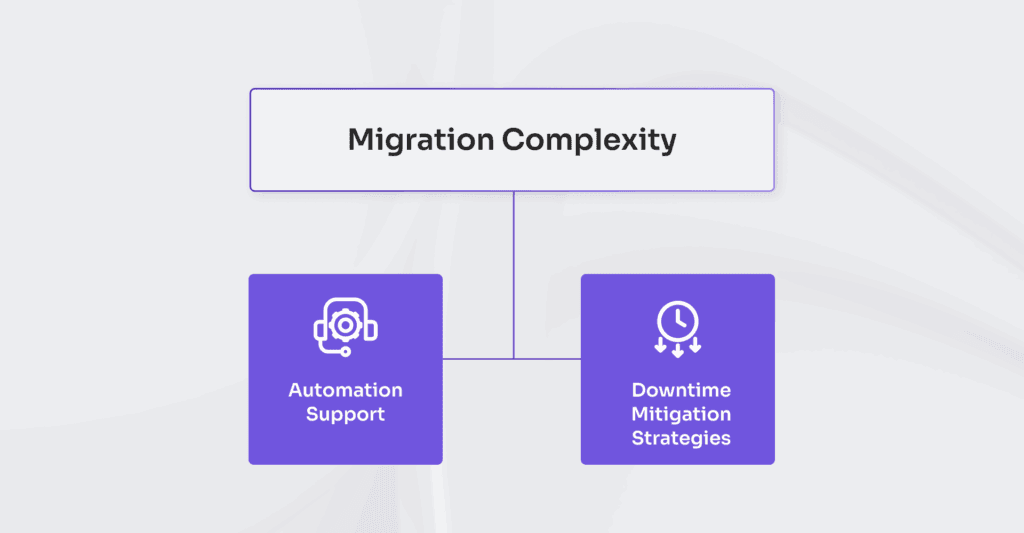
Migration complexity describes the degree to which enterprise hosting environments obstruct platform transition through systemic entanglement. Vendor-specific orchestration, proprietary configuration formats, and platform-bound pipelines create rigid dependencies that block architectural portability and decouple resistance.
Enterprise websites are structurally bound to their original environments by tooling, authentication, and service meshes tied to internal routing and observability layers.
Configuration incompatibility is central: hardcoded variables, non-abstracted secrets, and environment-locked deployment logic cause CI/CD pipelines to collapse outside native tooling. Release automation fails without parallel frameworks, binding execution to the host.
Database and identity systems further entrench dependencies. Schema customizations and access controls integrated with vendor APIs require costly behavioral replication. The result is a fragmented system that resists decoupling.
Operational fallout includes extended migration timelines, mandatory parallel staging, and risk-intensive rearchitecture. “Lift and shift” becomes infeasible; each layer demands tool replacement, retesting, and controlled cutovers. Absent abstraction and automation, redeployment overhead expands, and continuity risk spikes.
Automation Support
Automation support determines whether enterprise websites can execute deployment, migration, and scaling without manual intervention or vendor reliance. Enterprise hosting environments often restrict this support through proprietary DevOps frameworks, closed orchestration systems, and fragmented APIs, which bind infrastructure workflows to platform-specific tools and block execution independence.
Trigger availability is limited, and deployment and config changes often lack event exposure. Webhook access, if present, is superficial, disabling workflow integration for core infrastructure.
Automation support is blocked by CLI tools without cross-host compatibility and abstracted orchestration layers, such as managed Kubernetes with no cluster control, preventing infrastructure-as-code compatibility.
These constraints prevent pipeline portability, disable container lifecycle hooks, and break automation reuse during enterprise cloud hosting migration. Lack of event system exposure further blocks trigger-based deployment, leaving workflows untriggerable. Locked CI/CD systems force external replication and disable CI/CD decoupling, amplifying exit friction.
Each constraint introduces manual fallback, sync failures, and provisioning gaps, escalating migration complexity. Without exit automation support, enterprise websites face manual transitions and elevated downtime risk.
Downtime Mitigation Strategies
Downtime mitigation strategies determine whether enterprise websites can maintain continuity during hosting platform migration. This continuity depends on concrete systems: dual-deployment environments, DNS-level routing, container-based orchestration, validation staging, live sync, and rollback automation.
Most enterprise hosting platforms fail to support these. Blue-green deployments are blocked outside proprietary systems, forcing hard cutovers. Read-only replicas are absent, eliminating fallback buffers. DNS control is locked behind vendor dashboards, delaying failovers and tying stability to support timelines.
Real-time data sync is restricted to proprietary APIs, preventing mirrored systems and increasing data loss risk. Pre-migration validation is blocked by missing event hooks, removing dry-run capabilities, and inflating rollback rates.
Rollback mechanisms, when present, are often manual or paywalled, with CI/CD triggers disallowed. Monitoring tools for enterprise hosting are rarely interoperable across platforms, limiting visibility during migration windows and compounding the risk of undetected failures, configuration drift, and sync lags. Without vendor-agnostic mitigation paths, failures become prolonged outages.
Vendor constraints turn migration into an operational liability. Service disruption, data instability, and reputational harm are structural outcomes of platforms that condition continuity on ecosystem lock-in.
Migration Exit Costs
Migration exit costs are residual penalties imposed on enterprise websites disengaging from structurally entrenching hosting environments. These costs embed direct financial friction, license termination fees, SLA-triggered penalties, and indirect burdens like retraining overhead, tooling loss, and capability re-alignment.
Enterprise hosting embeds platform functionality within long-term contracts, triggering cost exposure through deactivated tiers, forfeited features, and non-refundable billing. SLA clauses impose exit penalties at migration notice or service claims, framing departure as vendor revenue protection.
Operational costs escalate when workflows and certifications are vendor-bound. Proprietary toolchains create non-transferable skills, while training system incompatibility imposes re-onboarding debt. Migration triggers rebuilds of automations, integrations, and access structures misaligned with new platforms. Retraining and reintegration are engineered dependencies.
Strategically, exit is high-friction; vendors entrench reliance through certified workflows and UI lock-in, amplifying resource debt with every embedded process. The deeper the enterprise website embeds, the costlier the break.
Migration exit costs are architected deterrents. Enterprise hosting amplifies lock-in through licensing traps, workflow rigidity, and certification monopolies. Migration triggers penalty stacks designed to delay or derail transition, regardless of technical feasibility.
License and SLA Exit Fees
License and SLA exit fees penalize enterprise websites for early termination or unauthorized migration. Vendors condition these costs into contracts to restrict disengagement. License models bind enterprises with long-term, prepaid terms that forfeit value on exit and escalate with growth but don’t scale down on departure.
SLA constraints further enforce lock-in through blackout clauses, extended notice periods, and exit-tier support pricing. Deactivation or data extraction triggers penalties, while platform usage remains billable. Support fees increase as feature access declines.
Exit clauses are platform-enforced; migration revokes support, throttles APIs, disables automation, and limits dashboards. The system shifts behavior to invalidate transition and coerce retention.
These mechanisms don’t just raise costs; they are strategic levers of vendor dependency. License and SLA exit fees are engineered to penalize choice, delay transition, and bind enterprises to the hosting platform.
Retraining and Resource Allocation
Retraining and resource allocation are operational costs imposed by enterprise hosting platforms when migration reveals non-transferable tooling, workflows, and knowledge domains.
These platforms entrench proprietary scripts, CLIs, automation pipelines, and monitoring stacks that fail outside vendor infrastructure. SDKs, API behaviors, and undocumented quirks trigger integration failures beyond their native context.
Enterprise websites inherit toolchain obsolescence. Retraining becomes mandatory. CI/CD logic is rewritten, scripting languages retired, and automation rebuilt. This transition consumes cycles, invalidates maturity, and redirects delivery capacity.
Resource reallocation follows; roles are redefined, monitoring stacks replaced, and documentation rewritten. Internal mismatches trigger hiring or consulting costs, inflating exit overhead.
These disruptions originate from hosting architecture, creating a hidden cost center rooted in operational knowledge lock-in. Retraining and resource allocation convert migration into organizational reorientation, slowing velocity and extending stabilization long after infrastructure shifts.
Strategic Alignment
Strategic alignment defines whether an enterprise website can evolve independently of its hosting provider’s platform roadmap. Hosting vendors constrain infrastructure autonomy by imposing scalability ceilings, throughput caps, storage limits, compute throttling, or unsupported edge deployments. These restrictions gate service expansion and bind feature development to vendor-paced rollouts, misaligned with enterprise velocity.
Feature gating and delayed integrations force dependency alignment. API lag, limited third-party compatibility, and roadmap opacity leave teams reacting to platform gaps rather than driving user-focused architecture. Strategic direction shifts from intentional design to roadmap-induced workaround.
Roadmap deprecations and forced migrations erode architectural continuity. Enterprises lose control over transition timelines, replacing deliberate scaling with sudden pivots dictated by platform cycles.
Shifting cost structures undermines economic viability. Licensing changes, compute taxation, or inflated integration fees destabilize scaling models, breaking financial planning assumptions.
Vendor Scalability Roadmap
The vendor scalability roadmap governs the platform’s timeline for feature access, infrastructure expansion, and service upgrades, determining when enterprise websites can scale. It sets the operational tempo for scaling enterprise hosting, converting internal readiness into a waiting game.
It gates autoscaling behind phased rollouts and postpones storage or orchestration upgrades until milestone releases. Enterprise hosting environments enforce these delays, restricting growth until roadmap thresholds are met.
This roadmap slows enterprise delivery by decoupling internal readiness from platform capability. Critical features remain locked, regions stay unsupported, and architecture extensions wait on vendor sequencing. Roadmap-bound region availability delays global expansion, freezing market entry until platform updates catch up.
Timeline opacity amplifies risk, milestones shift without notice, and support requests are deferred to undefined “phases.” API version gating fragments environments, misaligning development with deployment and blocking adoption across teams.
Enterprise websites become structurally dependent on vendor pacing. Scalability remains roadmap-bound, and growth is halted until the provider lifts the gate. Without control of the roadmap, enterprises surrender control of their own evolution.
Contact
Don't like forms?
Shoot us an email at [email protected]

Send a Project Brief
You need to load content from reCAPTCHA to submit the form. Please note that doing so will share data with third-party providers.
More InformationYou are currently viewing a placeholder content from Turnstile. To access the actual content, click the button below. Please note that doing so will share data with third-party providers.
More InformationYou are currently viewing a placeholder content from Facebook. To access the actual content, click the button below. Please note that doing so will share data with third-party providers.
More InformationYou are currently viewing a placeholder content from Instagram. To access the actual content, click the button below. Please note that doing so will share data with third-party providers.
More InformationYou are currently viewing a placeholder content from X. To access the actual content, click the button below. Please note that doing so will share data with third-party providers.
More Information
